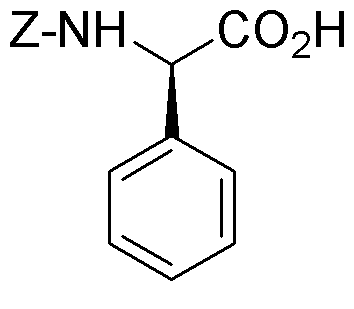Z-D-phenylglycine is widely utilized in research focused on:
- Pharmaceutical Development: It serves as a building block in the synthesis of various pharmaceuticals, particularly in creating peptide-based drugs that target specific biological pathways.
- Biotechnology: This compound is essential in the development of enzyme inhibitors, which can be used to regulate metabolic pathways and treat diseases such as cancer and diabetes.
- Protein Engineering: Researchers use Z-D-phenylglycine to modify amino acid sequences in proteins, enhancing their stability and activity for therapeutic applications.
- Analytical Chemistry: It acts as a chiral auxiliary in asymmetric synthesis, allowing for the production of enantiomerically pure compounds, which are crucial in drug formulation.
- Material Science: The compound is explored in the creation of novel materials, such as hydrogels, which have applications in drug delivery systems and tissue engineering.
General Information
Properties
Safety and Regulations
Applications
Z-D-phenylglycine is widely utilized in research focused on:
- Pharmaceutical Development: It serves as a building block in the synthesis of various pharmaceuticals, particularly in creating peptide-based drugs that target specific biological pathways.
- Biotechnology: This compound is essential in the development of enzyme inhibitors, which can be used to regulate metabolic pathways and treat diseases such as cancer and diabetes.
- Protein Engineering: Researchers use Z-D-phenylglycine to modify amino acid sequences in proteins, enhancing their stability and activity for therapeutic applications.
- Analytical Chemistry: It acts as a chiral auxiliary in asymmetric synthesis, allowing for the production of enantiomerically pure compounds, which are crucial in drug formulation.
- Material Science: The compound is explored in the creation of novel materials, such as hydrogels, which have applications in drug delivery systems and tissue engineering.
Documents
Safety Data Sheets (SDS)
The SDS provides comprehensive safety information on handling, storage, and disposal of the product.
Product Specification (PS)
The PS provides a comprehensive breakdown of the product’s properties, including chemical composition, physical state, purity, and storage requirements. It also details acceptable quality ranges and the product's intended applications.
Certificates of Analysis (COA)
Search for Certificates of Analysis (COA) by entering the products Lot Number. Lot and Batch Numbers can be found on a product’s label following the words ‘Lot’ or ‘Batch’.
*Catalog Number
*Lot Number
Certificates Of Origin (COO)
This COO confirms the country where the product was manufactured, and also details the materials and components used in it and whether it is derived from natural, synthetic, or other specific sources. This certificate may be required for customs, trade, and regulatory compliance.
*Catalog Number
*Lot Number
Safety Data Sheets (SDS)
The SDS provides comprehensive safety information on handling, storage, and disposal of the product.
DownloadProduct Specification (PS)
The PS provides a comprehensive breakdown of the product’s properties, including chemical composition, physical state, purity, and storage requirements. It also details acceptable quality ranges and the product's intended applications.
DownloadCertificates of Analysis (COA)
Search for Certificates of Analysis (COA) by entering the products Lot Number. Lot and Batch Numbers can be found on a product’s label following the words ‘Lot’ or ‘Batch’.
*Catalog Number
*Lot Number
Certificates Of Origin (COO)
This COO confirms the country where the product was manufactured, and also details the materials and components used in it and whether it is derived from natural, synthetic, or other specific sources. This certificate may be required for customs, trade, and regulatory compliance.


